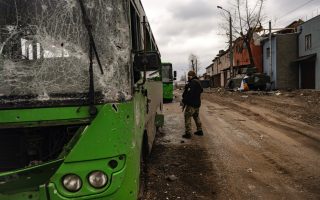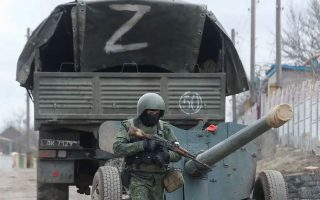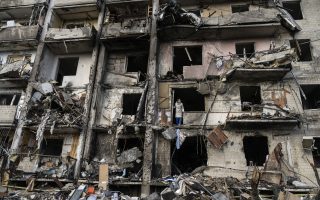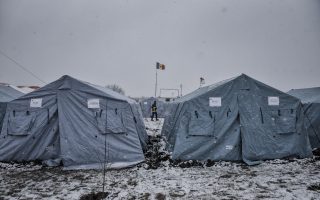Ukrainian forces strike back at Russia, as Biden sends more firepower
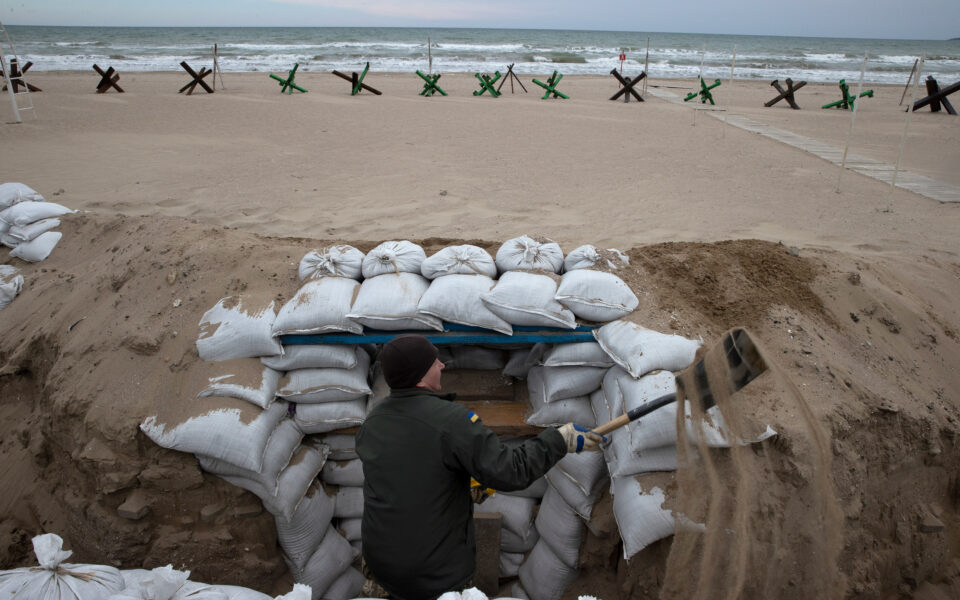
ODESA, Ukraine – Ukrainian forces carried out counter-offensives against Russian positions Wednesday, seeking to inflict what one official called “maximum losses,” even as the invading Russian military stepped up its lethal attacks on cities.
In Mariupol, an airstrike destroyed a theater where about 1,000 people had taken shelter, according to city and regional administrators, and photos and videos posted online showed the burning wreckage of the building.
Officials in Mariupol, the besieged southern city that has suffered the most intense bombardment, said they could not yet estimate the number of casualties among civilians, who might have been in a bomb shelter beneath the theater. The strike came as 11,000 residents evacuated the city on Wednesday, according to its city council.
In a video address to Ukrainians early Thursday morning, President Volodymyr Zelenskyy called for more sanctions against Russia and said it was a “terrorist state.”
“Our hearts are broken by what Russia is doing to our people,” he said, “to our Mariupol.”
After falling back under a relentless pounding over the war’s first weeks, Ukrainian troops tried to gain some momentum with counterattacks on Russian positions outside of Kyiv and in the Russian-occupied city of Kherson, in Ukraine’s south, a senior Ukrainian military official said.
Rather than seek to regain lost territory, Ukrainian forces tried to cause as much destruction and death as possible, attacking Russian troops and equipment with tanks, fighter jets and artillery, the official said, speaking on condition of anonymity to discuss sensitive military information.
“In the task of inflicting maximum losses, we’ve done excellently,” the official said.
American intelligence officials said their conservative estimate of Russian troop deaths was at least 7,000, a staggering number that carries implications for both combat effectiveness and morale. Western defense and intelligence agencies estimate that Ukraine also has suffered thousands of combatants killed.
Zelenskyy addressed Congress via video link Wednesday, asking for more aid, and President Joe Biden promised more weaponry. The administration plans to provide Ukraine with high-tech defensive weapons that are easily portable and require little training or logistical support to use, according to U.S. and European officials.
Meanwhile, President Vladimir Putin of Russia falsely accused Ukraine of seeking weapons of mass destruction and asserted that what he called an “economic blitzkrieg” by the West, aimed at destroying Russia, had failed.
Putin also sneered at Russians who oppose the war, saying the Russian people could distinguish “true patriots from the scum and the traitors, and just to spit them out like a midge that accidentally flew into their mouths.”
In a televised videoconference with top officials, he once again falsely described the government in Kyiv, led by a Jewish president and prime minister, as being “pro-Nazi” and on its way to acquiring nuclear weapons. “Their aim, of course, would have been Russia,” he said.
And then he went deeper into unreality, accusing the government in Kyiv of disregard for the suffering of the Ukrainian people that his own forces were bombing every day.
“The fact that people are dying, that hundreds of thousands, millions have become refugees, that there is a real humanitarian catastrophe in cities held by neo-Nazis and armed criminals,” he said. “They’re indifferent.”
Ukrainian and Russian negotiators held a third consecutive day of talks on a possible settlement to the conflict, and in typical fashion, the Kremlin left a muddy picture of its intentions. Putin’s bellicose, often false statements, larded with World War II references, clashed with more conciliatory comments from his underlings.
But little appeared to have changed on the battlefield. The war in Ukraine, about to enter its fourth week, has become a grinding daily slog with little evidence of significant gains for either side.
Details of the Ukrainian offensive could not be fully established independently, though several top Ukrainian officials, including key aides to Zelenskyy, confirmed that the counterattacks were underway.
In Kyiv, missile strikes and heavy artillery sounded overnight and in the early morning Wednesday in exchanges in the outlying suburbs that were notably heavier and louder than in previous days. Two people were wounded and a residential building was damaged in a strike that landed near the city zoo, the second time in two days that shells have landed close to the city center.
Satellite pictures from Tuesday showed heavy black smoke above the Kherson airport, where the senior military official said Ukrainian forces had targeted parked Russian military aircraft.
Kherson was the first (and so far, only) major city to be fully taken over by Russian forces, which have turned it into a forward military base from which they have launched attacks on surrounding cities and villages, according to Ukrainian officials. On Tuesday, the Russian Defense Ministry announced that it had taken control of the entire Kherson region, giving Russian forces a significant foothold in southern Ukraine that Ukraine’s military will have difficulty dislodging.
Even so, neither side can be said to have made much progress militarily. The Institute for the Study of War, which has been tracking developments closely, noted in a Tuesday evening assessment that, for nearly two weeks, Russian forces have not been conducting extensive simultaneous attacks that would allow them to seize control of multiple areas at once in Ukraine. And they are unlikely to do so in the next week, it said.
In the absence of significant military gains, Russian forces Wednesday continued a campaign of terror against Ukrainian civilians.
At least 10 people were killed when a Russian strike hit a bread line in Chernihiv, a city north of Kyiv that has been subject to intense shelling by Russian troops seeking to move on the capital. Ukraine’s prosecutor general’s office said in a statement that the attack occurred at about 10 a.m. as people were lined up at a grocery store. Photos released by the prosecutor’s office showed several bodies scattered around a dirt yard.
Using heavy artillery, cruise missiles and fighter jets, Russian forces have systematically targeted civilian areas with no military presence, striking apartment buildings, schools and hospitals in cities and villages all over a broad front in the north, east and south of Ukraine. The attacks may have killed thousands of civilians, though reaching a precise count of the dead has been impossible.
Saying it was “profoundly concerned” by Russia’s use of force, the International Court of Justice ordered Russia on Wednesday to suspend its military operations immediately, pending its full review of a case submitted by Ukraine last month. However, the order was not expected to lead to any immediate cessation in the onslaught.
According to the United Nations, at least 726 civilians have been killed, including 64 children, since the invasion began Feb. 24, though its figures do not include areas where fighting has been heaviest, like Kharkiv and Mariupol. In Mariupol alone, which has been turned into a hellscape of burning and decimated buildings, local authorities say at least 2,400 have been killed, and probably far more.
In Kharkiv, Ukraine’s second largest city, the municipal emergency services agency first reported Wednesday that 500 civilians had been killed since the war began, but then revised that number to 100 later in the day. In any case, the agency said in statement on Facebook, the true number of deaths could be much higher, noting that emergency workers were continuing to scour the rubble of residential neighborhoods for more bodies, often under fire.
Zelenskyy’s appeal to Congress on Wednesday was in part a desperate effort to obtain the weaponry and defenses capable of fending off such attacks. Central to this appeal was a call for a no-fly zone to be imposed over Ukraine, aimed at preventing Russian fighter jets, which cause some of the most severe death and destruction, from operating over Ukrainian territory. “Close the sky” has become a rallying cry for Ukrainian officials and regular citizens.
“Russia has turned the Ukrainian sky into a source of death for thousands of people,” Zelenskyy said.
Knowing that the request had little chance of being approved, given that it would thrust U.S. pilots into direct confrontation with the Russians, Zelenskyy quickly pivoted to something to which Republicans and Democrats have been far more receptive: asking for more weapons to enable his people to keep up the fight themselves.
Biden announced $800 million in new military aid to Ukraine, including anti-aircraft and antitank missiles, body armor, vehicles, drones and small arms, bringing to $2 billion the amount delivered or pledged since early last year. But as expected, he did not offer to deliver warplanes or enforce a no-fly zone.
The U.S. and its allies have relied primarily on financial sanctions that are already devastating the Russian economy.
Russian officials close to the talks said Wednesday that there had been signs of progress, though even there, the picture was unclear. They said the idea of a neutral Ukraine, with a status like that of Sweden or Austria, was on the table, which their Ukrainian counterparts disputed.
Sergey Lavrov, Russia’s foreign minister, told a Russian television network that the status of the Russian language and Russian news outlets in Ukraine were under discussion, and that “there are concrete formulas that are close to being agreed on.”
This article originally appeared in The New York Times.



